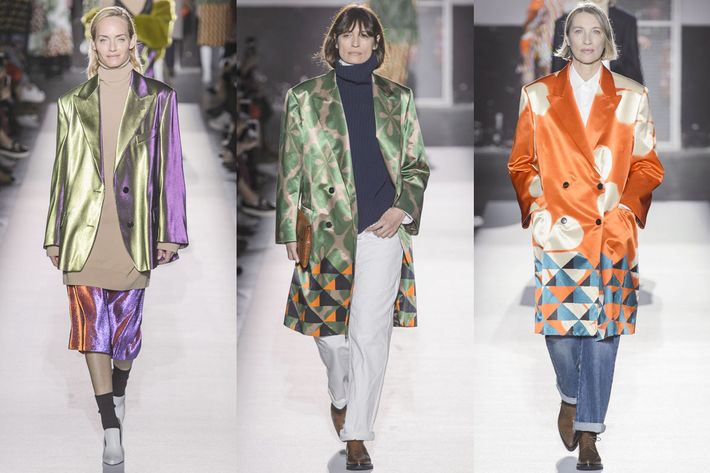The runway is a strange place to experience a sense of loss. One would have thought it the last place, in fact. You might weep at the length of some of the Paris shows — 106 looks at Saint Laurent, 80 at Balmain — but nobody can feel bad about Kendall Jenner dressed as a crocodile at Balmain, the skins molded to her body, except for maybe the crocodile. Like the frighteningly short minis and glitter boots at Saint Laurent, it was exactly what you’d expect from a hyper-brand looking to go viral on social media.
But loss is what I felt during the Dries Van Noten show — and I don’t mean nostalgia. This was Van Noten’s 100th show, and as he told the Times beforehand, he wanted to do something special but also simple, because “we are in a period of fashion overdose right now,” adding: “There’s too much pressure.” The Antwerp-based designer also said that in the 25 years since he began showing in Paris, the models and the front-row stars have eclipsed the clothes, thanks to Instagram; “and everything got much more expensive.”
Van Noten is hardly a bitter kind of guy, and he has no reason to be. He has built one of the few successful independent businesses in fashion. His showroom yesterday was packed with buyers when I stopped by to see him. Long ago he decided not to advertise because he didn’t want to soak his customers — as the big brands do — with that cost. Clothes are already expensive enough.
But built in to Van Noten’s statement is loss, of the thousands if not millions of women who no longer connect with high fashion, or perhaps only connect through an image on Instagram — Kendall in a croc. Jean-Jacques Picart, a retired LVMH executive, made a similar comment to me while we were waiting for another show to start. Despite the massive audience for fashion, the public has checked out, partly because people have more demands today on their time and money but also because the clothes aren’t relevant to their lives. Instead we have too many brands, dying department stores, the staggering cost of goods.
The loss I felt during the Van Noten show was something different, though. It actually left me feeling positive — connected to the world, and to my own past as an observer of fashion. He invited back models who’d been in his earlier shows — women like Kirsten Owen, Trish Goff, Malgosia Bela, Emma Balfour, and Hannelore Knuts — along with current girls, 56 in all. Van Noten also reprised fabrics from earlier collections — gorgeous wallpaper florals, discreet foulards, paisleys layered with geometric grids. And he turned the dated swatches into a bound book for each guest, as a keepsake but also as a reminder of how much ground Van Noten’s company has covered since 1992.
Without makeup or fancy hair, the older models looked like themselves — that is, they looked like women in their late 30s and 40s. Van Noten told me, “That generation also understands what they’re wearing.” Often, when he puts an oversized coat on a young model, it’s clear to him that she has no idea how to carry it off. “In the end,” he said, “you feel you’re dressing dolls.”
The older models didn’t just “own” the oversized printed jackets and coats, shown with wide-leg jeans and corduroy trousers, they also made these classic styles look convincingly fresh. Marc Jacobs did something similar this season, when he showed so many great coats with track pants or jeans.
His was also a show brilliantly connected to the past — the New York of the ‘70s and ‘80s — especially to the idea of feeling good and happy in what you wore. Right after the New York shows, I happened to read Kathryn Schulz’s wonderful essay on loss in The New Yorker. She mentioned a story told by Patti Smith in her memoir M Train about a beloved coat that she lost: “Every time I put it on,” Smith wrote, “I felt like myself.” That was the sense at Jacobs’s show, and it was certainly true at Van Noten.
Maybe a woman dressed in a Saint Laurent leather bustier dress with a fat scallop fringe would feel herself. I mean, Anthony Vaccarello’s designs for the brand were just fine, as were the animal-themed clothes by Olivier Rousteing at Balmain. (I especially liked the odd, decorative poncho dresses near the start of the show.) On the other hand, those collections didn’t make my mind leap elsewhere.
As Van Noten demonstrated, it is possible to acknowledge and even deal with inevitable loss and change in an imaginative way. Indeed, few things mark the passage of time more than a woman’s face, however beautiful, and the shoulders of a jacket.
I said to Van Noten, who had already begun to pick the fabrics for next season, “I guess everything moves on, doesn’t it?”
He nodded. “And it’s not a problem.”







